Our Verdict
The GeForce RTX 2080 Super has the fastest clocked GDDR6 we've seen so far. It's only slightly faster than the 2080 it replaces, without the Founders Edition shenanigans.
For
- Great for 1440p and even 4K
- Still hope for ray tracing
- Fastest GDDR6 clocks so far
Against
- Only a bit faster than RTX 2080
- Not at all revolutionary
- Needs a killer ray tracing app
PC Gamer's got your back
Rounding out Nvidia's triple play of Super cards (still a cringeworthy name in my book), we have the Nvidia GeForce RTX 2080 Super joining the pantheon of the best graphics cards and included in some of the best gaming PCs. With no real thread from AMD at the high-end, the RTX 2080 and 2080 Ti remain unchallenged. Still, it's nearly a year after the launch of the GeForce RTX cards, and just in time for the back-to-school season, Nvidia has new and improved product refreshes available.
The 2080 Super specs were released earlier in the month, and they're exactly what you'd expect from a mid-cycle product update: Take the same TU104 GPU that's used in the RTX 2080 (and 2070 Super now), enable all of the streaming multiprocessors (SMs) and CUDA cores, and crank the GDDR6 memory clock from 14Gbps up to 15.5Gbps. Depending on your reference point, GPU clocks are either nearly the same (2080 Founders Edition) or about 100MHz faster (reference 2080 clocks). It's not an incredibly exciting launch, in other words.
If you already bought an RTX 2080, you can get nearly the same level of performance via overclocking (specifically, increasing the GDDR6 clocks). If you've been thinking about buying a $700 graphics card, the RTX 2080 Super now claims top honors—and this time there's no $100 price premium at play if you buy the Founders Edition direct from Nvidia. (Technically speaking, Nvidia isn't using the Founders Edition branding with the new Super cards, but that's basically what they are.)
Here's what Nvidia's RTX product stack looks like, though the RTX 2070 and RTX 2080 (non-Super) are now in the process of being phased out.
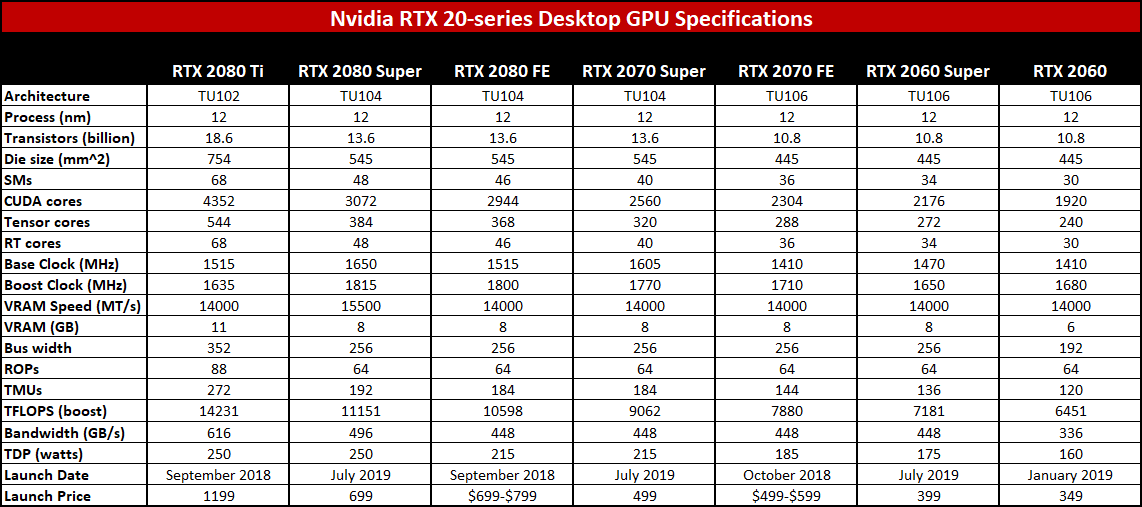
There's a bit more separation between the 2080 Super and the 2070 Super this round, since only the 2080 Super gets 15.5Gbps GDDR6. Nvidia isn't bothering with a 2080 Ti Super just yet, but if such a card were to release in the future, the story would be very much like the 2080 Super I'm reviewing today. More cores, faster memory, same price. Maybe such a card will 'magically' appear in another month or two, but for now Nvidia has said there will be no 2080 Ti Super.
As far as the RTX 2080 Super is concerned, this is the maxed-out implementation of the TU104 chip. All the SMs, cores, and memory controllers are enabled, and clockspeeds have been pushed about as far as you're likely to see. Sure, you can probably squeeze a few percent more performance out of the card via manual overclocking, but it's definitely going to be a case of diminishing returns. Notice how the TBP (typical board power) has already jumped 35W compared to the 2080. Power use has increased more than performance, indicating the GPU is nearing the limits of its design.
In terms of features, nothing has changed since last year's GeForce RTX launch. Nvidia's Turing architecture is still the building block of the current generation graphics cards, and the RTX cards all feature Tensor cores for deep learning and DLSS, along with RT cores to help accelerate the ray/triangle intersection calculations at the heart of ray tracing algorithms. At least there are now five fully released ray tracing games available—six once Wolfenstein: Youngblood launches on Thursday. We'll be looking at performance in Youngblood later this week, but for now I'm keeping ray tracing features off for the performance tests so that I can compare AMD and Nvidia results.
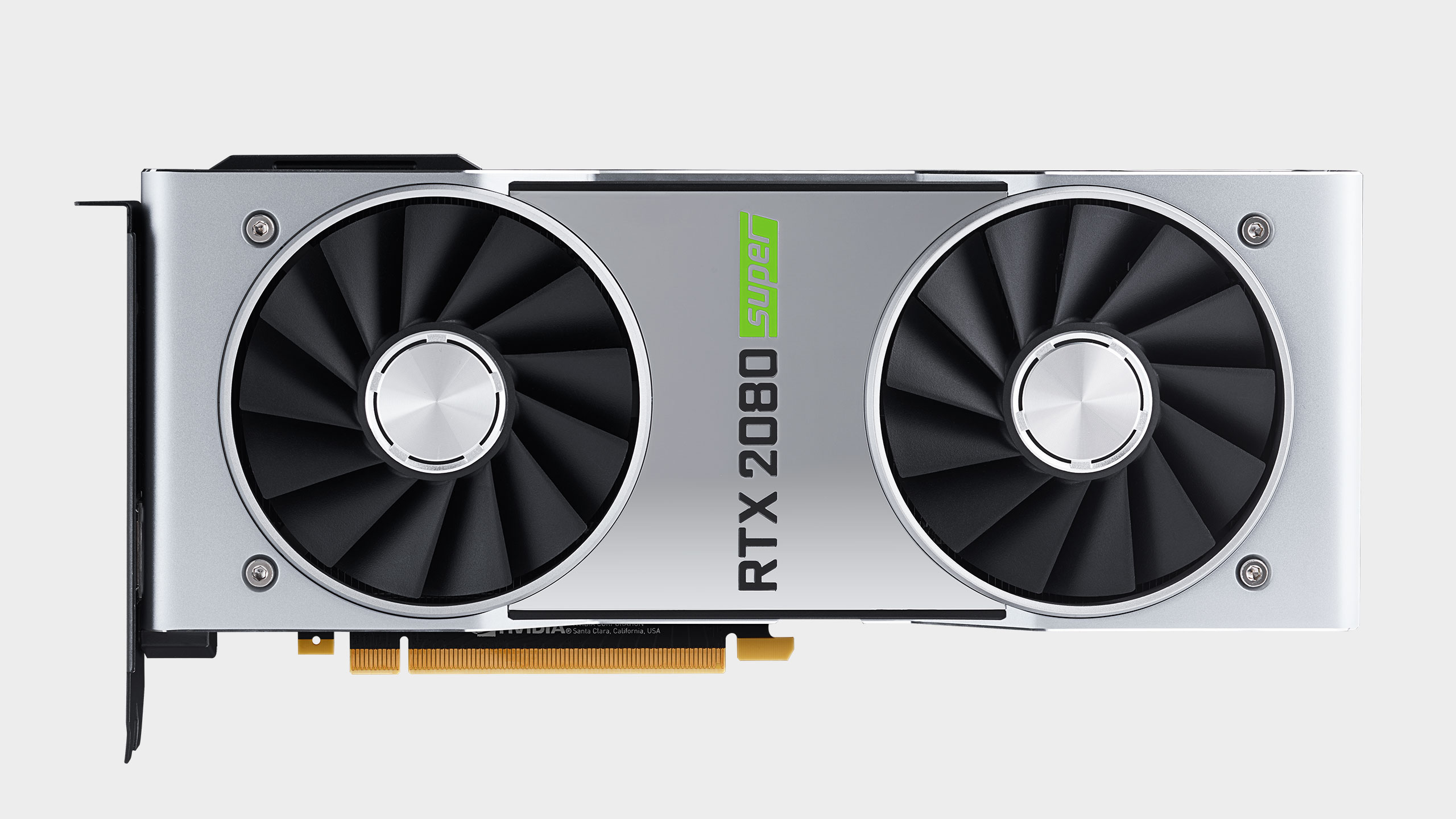
I continue to use our standard GPU testbed from about two years ago. It includes a Core i7-8700K overclocked to 5.0GHz to ensure the CPU isn't a bottleneck in testing. In a few instances an i7-9700K or i9-9900K might be fractionally faster in games, but typically the difference is less than two percent. The PC also uses fast DDR4-3200 CL14 G.Skill memory and SSD storage to ensure the GPU is the limiting factor in performance (as much as possible).
I've benchmarked using the latest drivers from Nvidia provided for the RTX 2080 Super, version 431.56. I've also retested the Nvidia cards in a few games, notably Forza Horizon 4 and Strange Brigade, as performance seems to have jumped quite a bit since the 430.86 drivers used in previous reviews. Otherwise the setup is the same as what I used with the Radeon RX 5700 and RX 5700 XT reviews, which still have a bug/issue in Shadow of War that causes poor performance at ultra quality on the Navi cards.

Nvidia's expectations for the RTX 2080 Super are that it will be about 5-10 percent faster than a reference RTX 2080, or about five percent faster than the RTX 2080 Founders Edition (which comes with a 90MHz increase in boost clock). I'm using 'reference' cards provided by AMD or Nvidia wherever possible for my testing, which means Founders Editions on the 2070/2080/2080 Ti models, and that means a 90MHz factory overclock.
I'm testing with 11 games that include a pretty even mix of AMD and Nvidia promoted titles. DirectX 12 is utilized in most cases, with the exception of Total War: Warhammer 2 where the "DX12 Beta" performance is particularly weak on Nvidia GPUs. Each card is tested at four settings: 1080p medium (or equivalent) and 1080p/1440p/4k ultra (unless otherwise noted). Every setting is tested multiple times to ensure the consistency of the results, and I use the best score. Minimum FPS is calculated by summing all frametimes above the 97 percentile and dividing by the number of frames, so that it gives a reasonable representation of the lower end of the performance scale, rather than looking only at the single worst framerate from a benchmark run.
Here are the results, which I won't comment on until after all the pretty charts. (Who am I kidding? I know you're all just here for the bar graphs.)
GeForce RTX 2080 Super performance



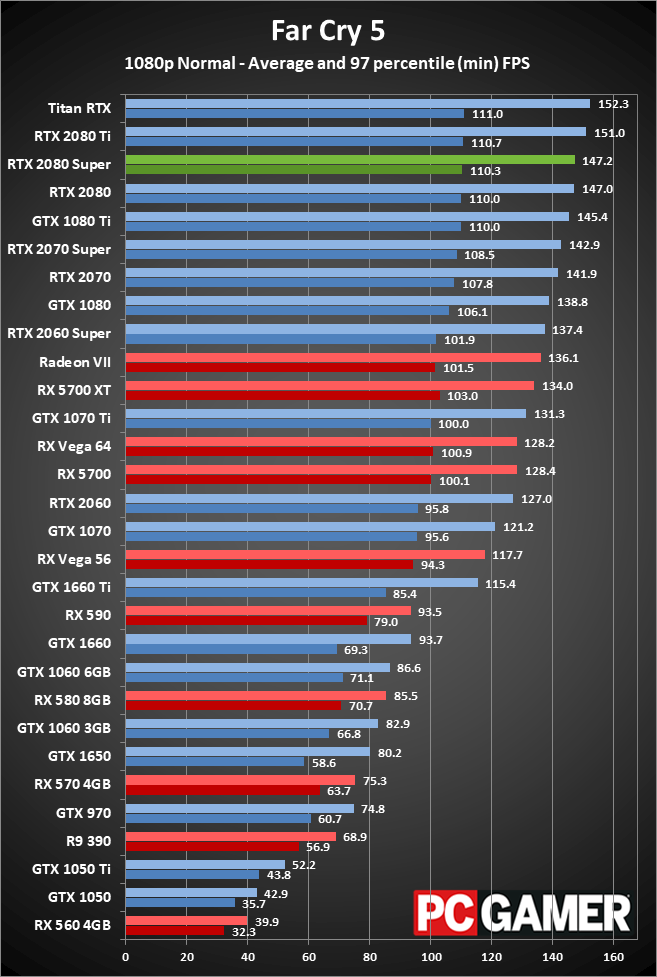
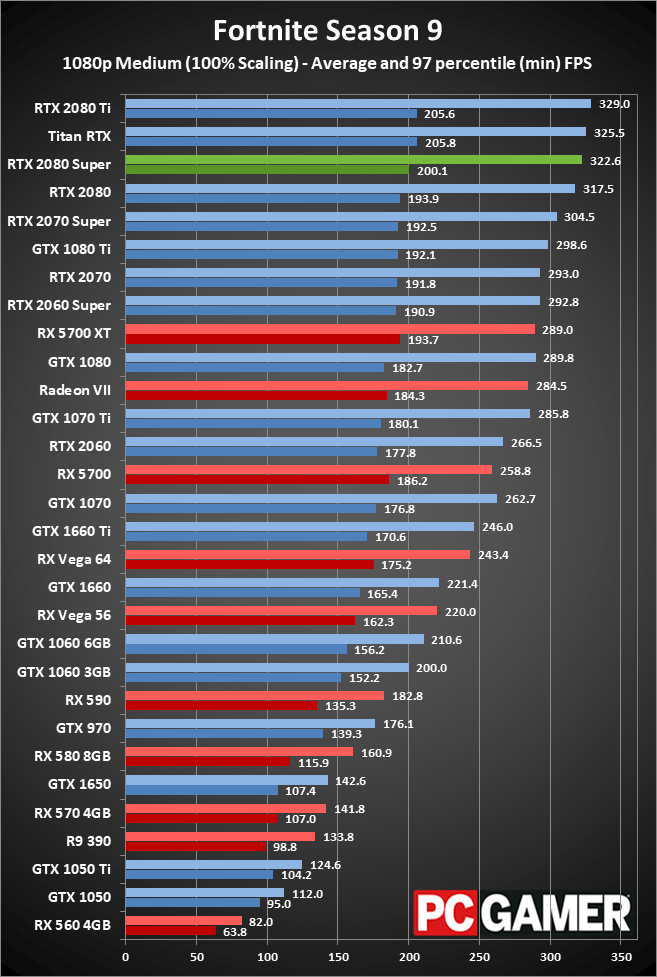
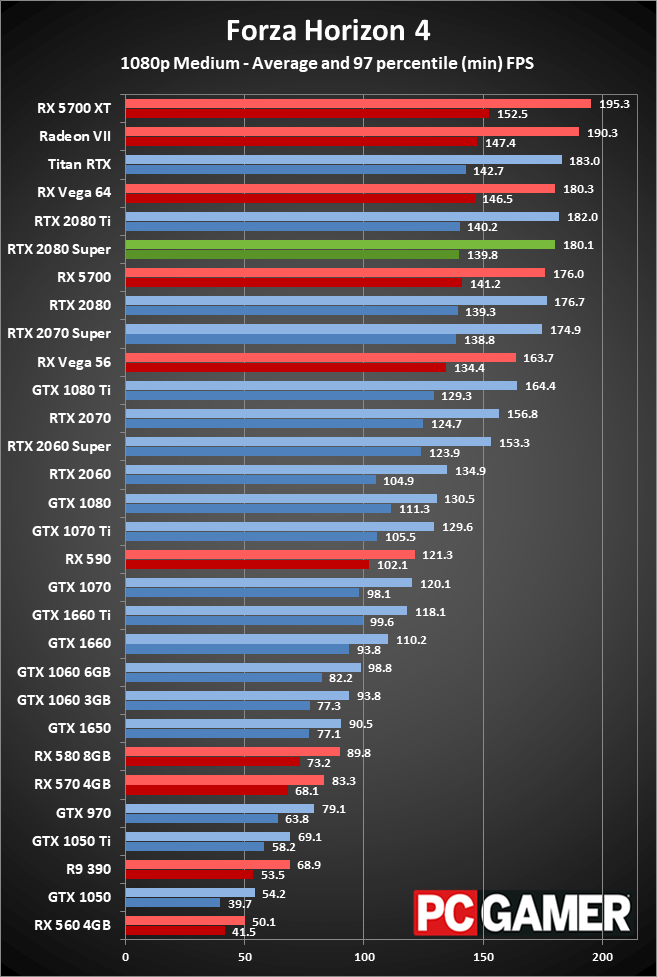
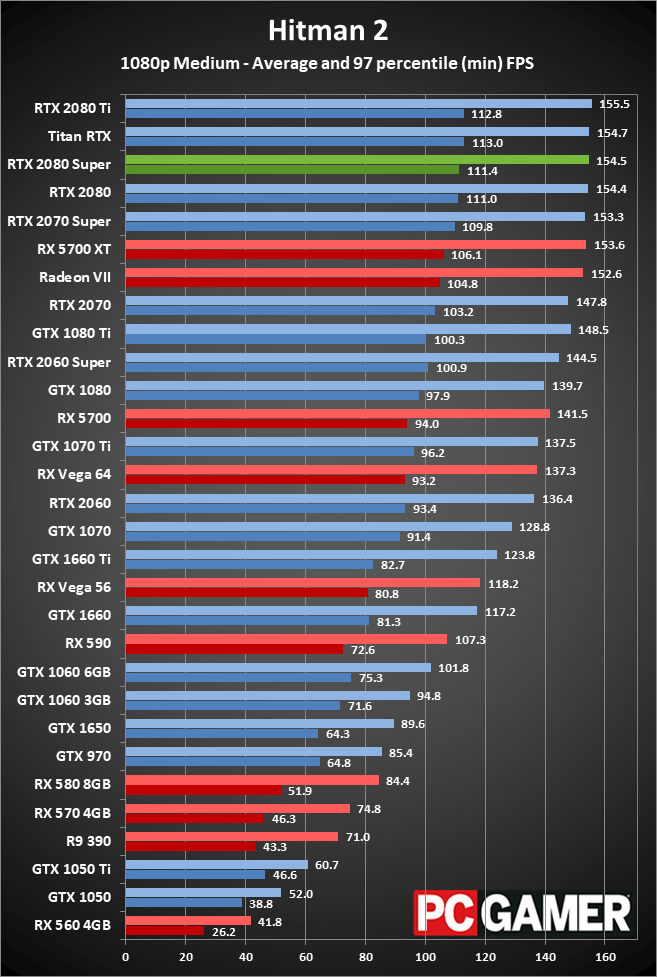
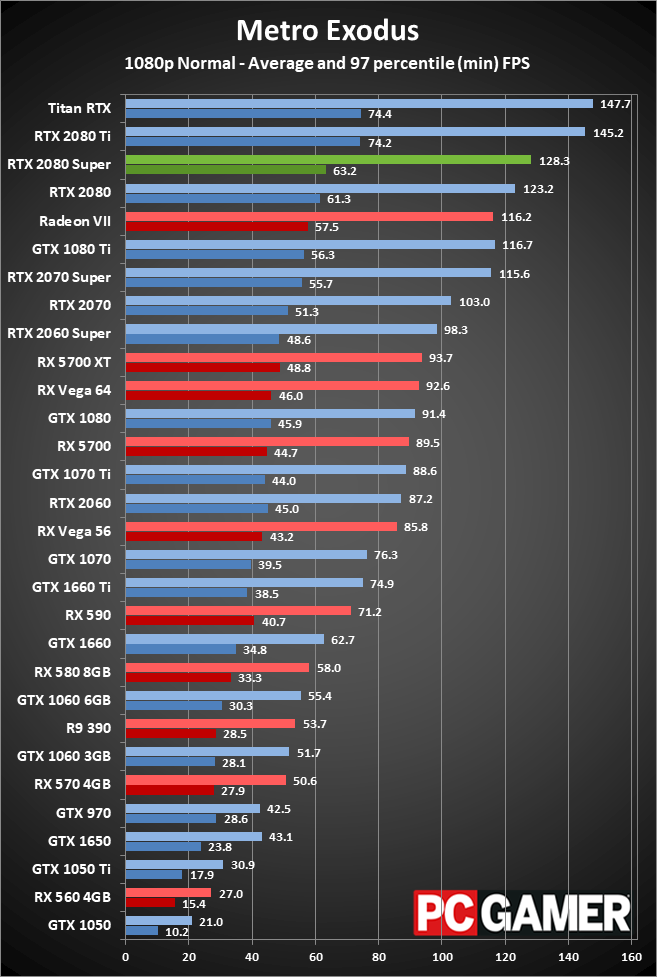
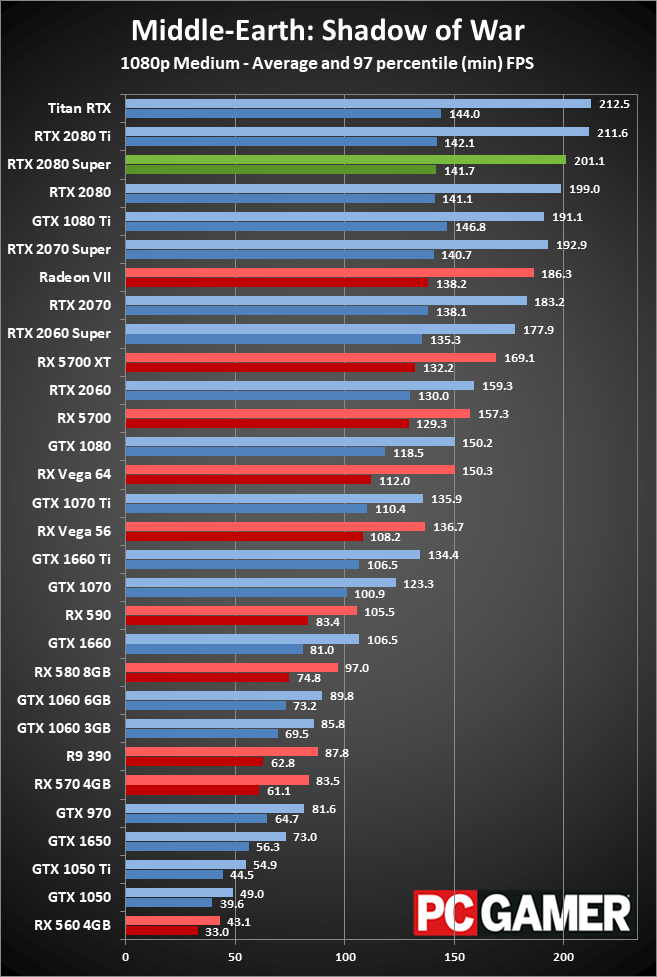
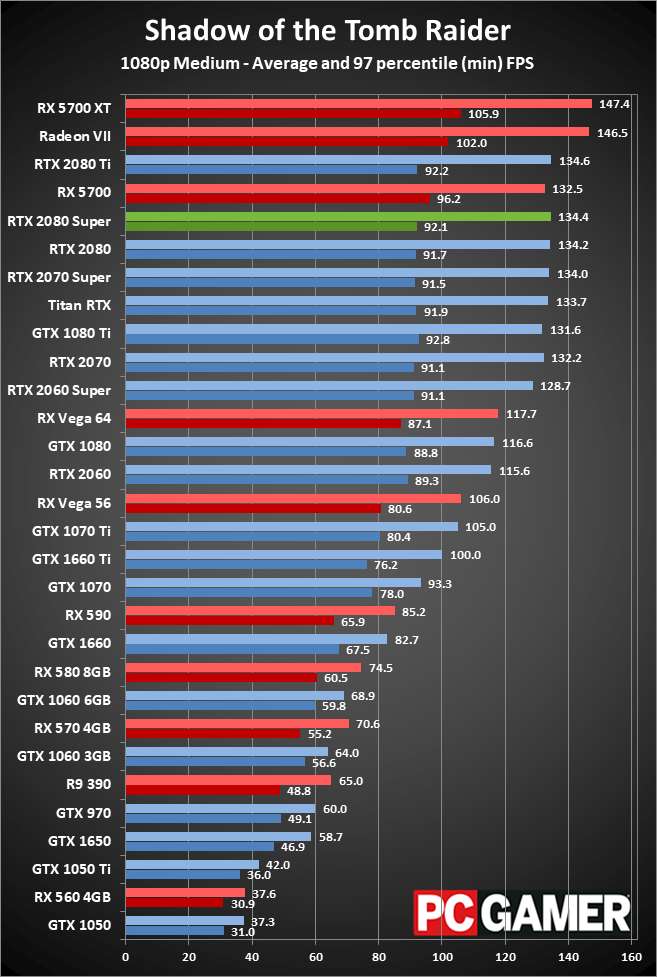
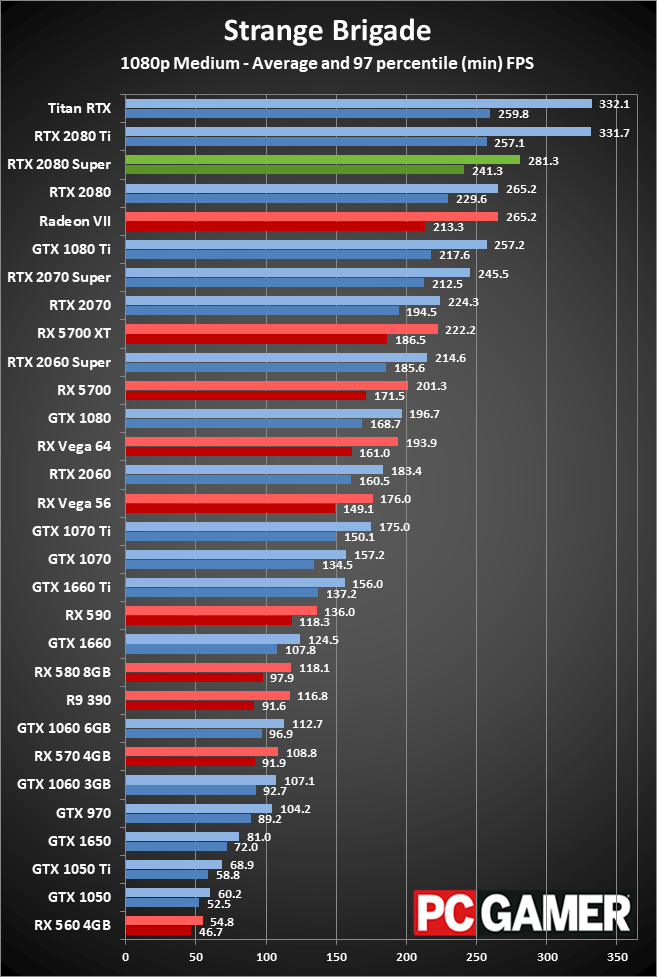


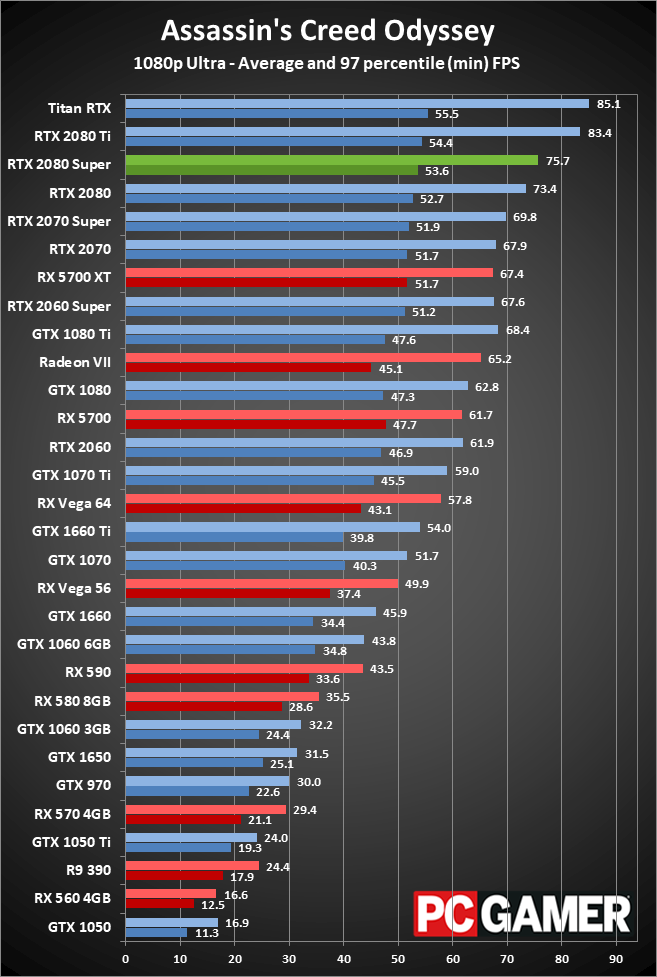
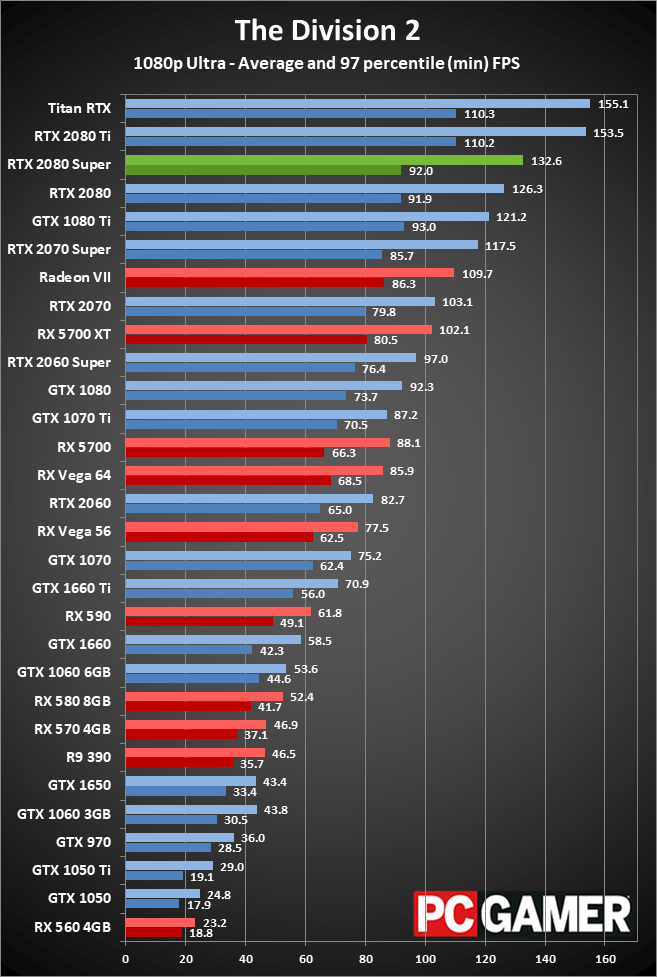
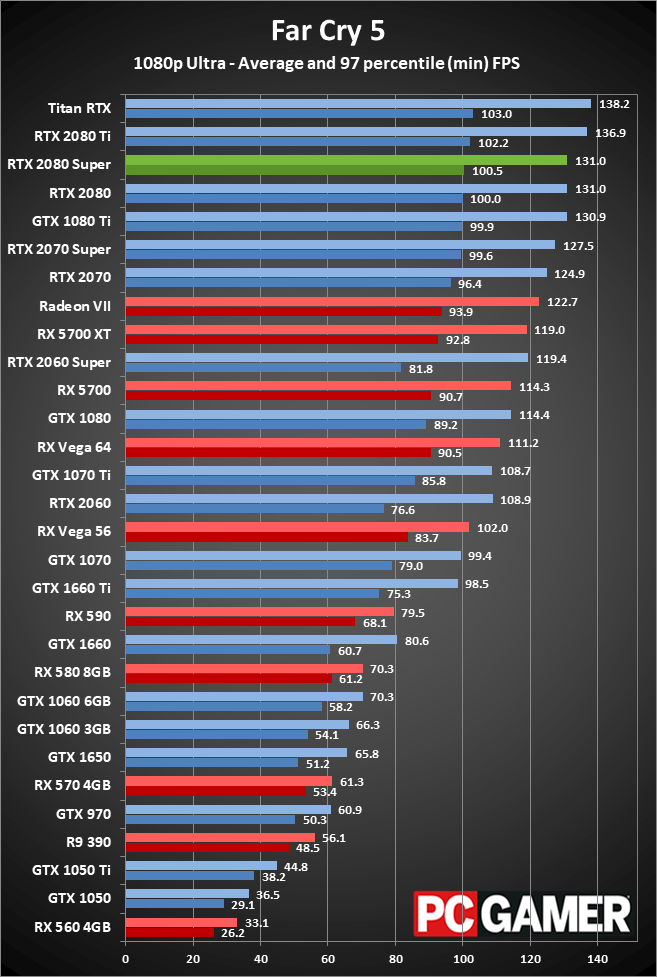
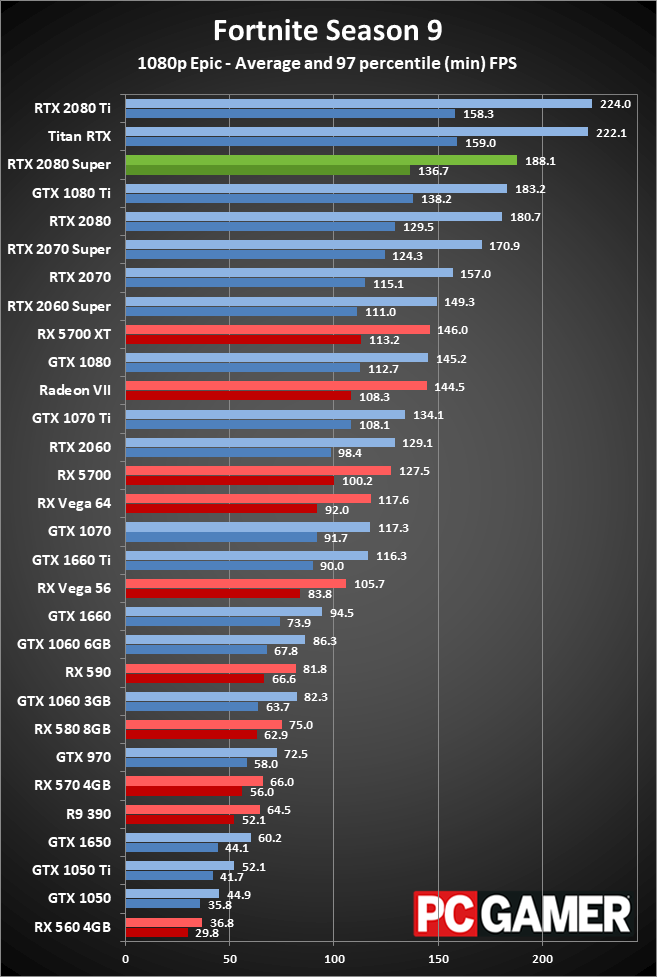
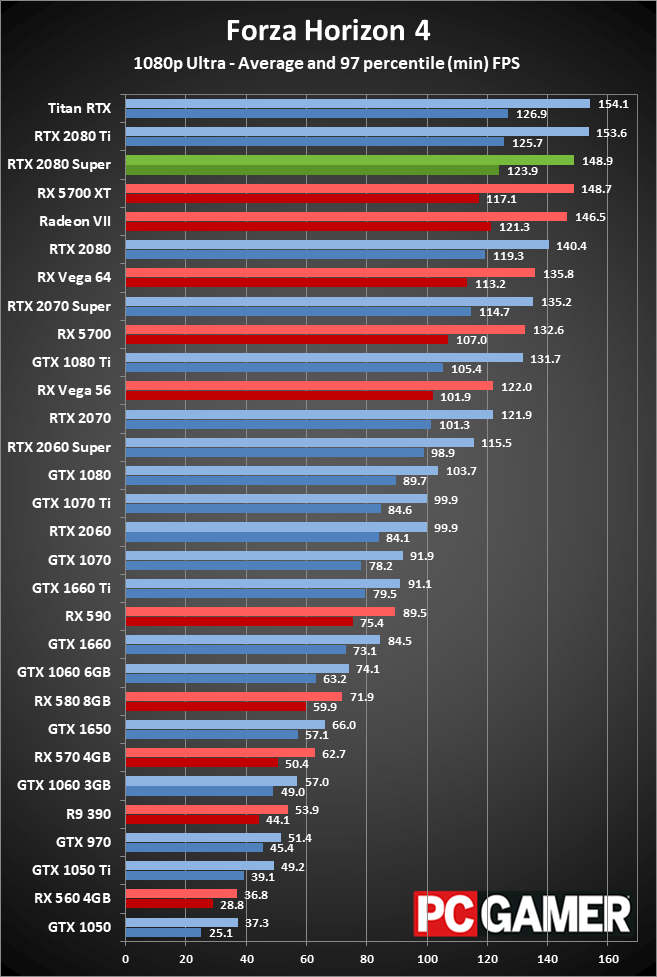


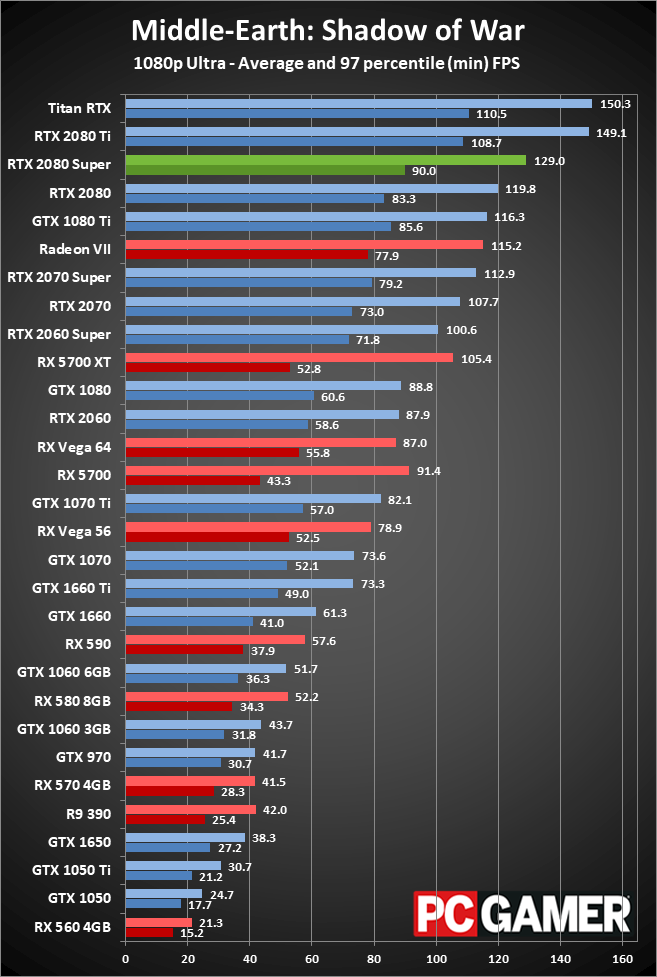

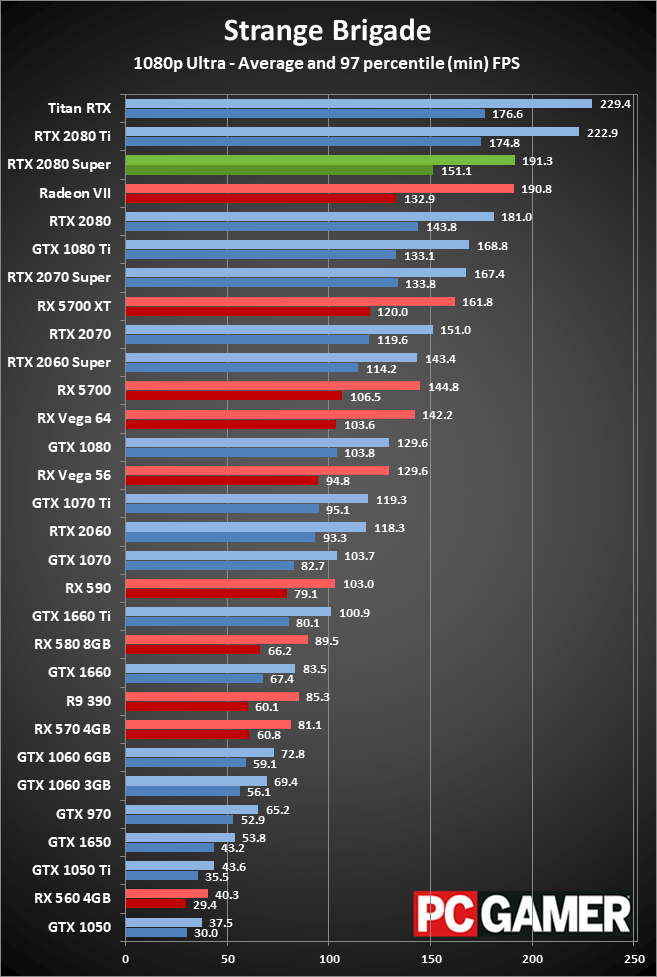
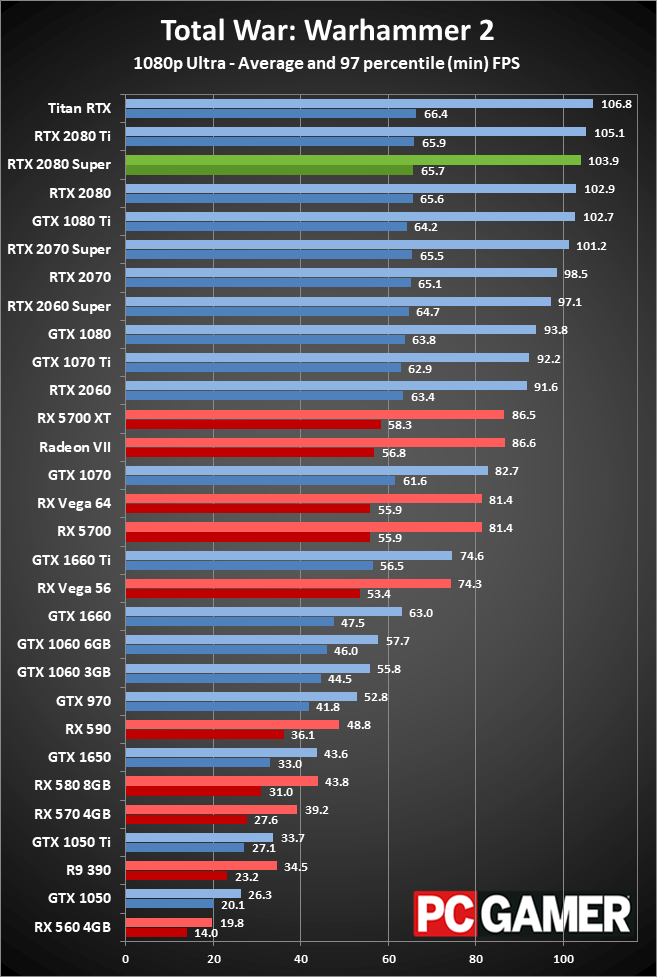
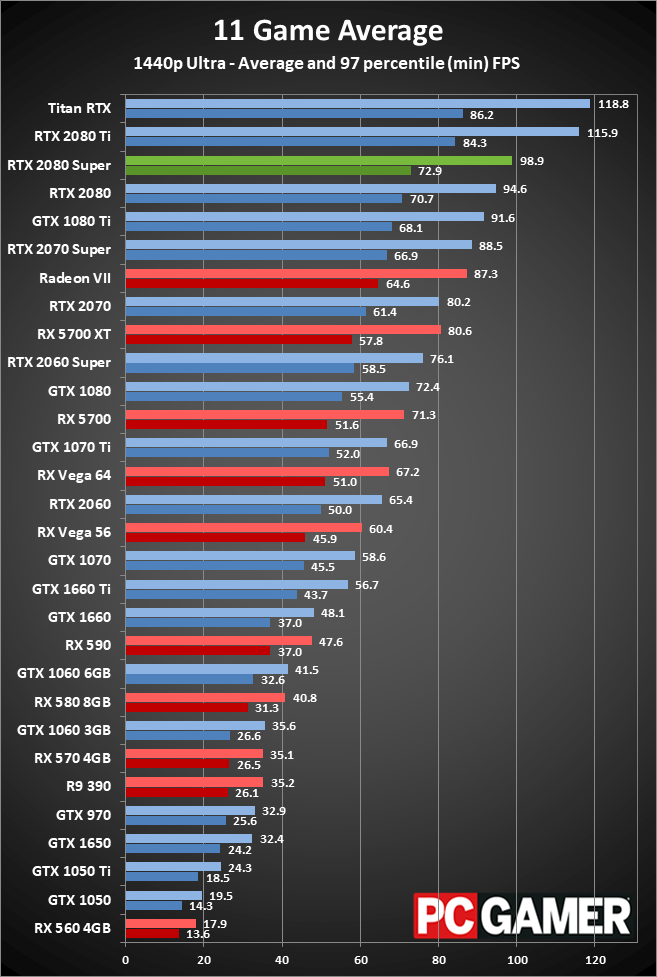


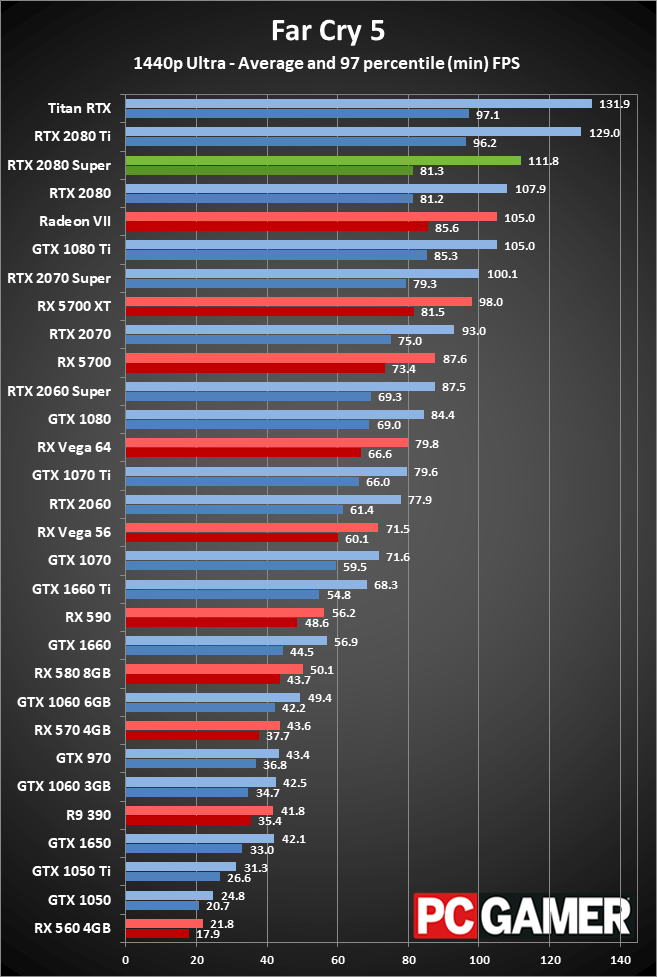
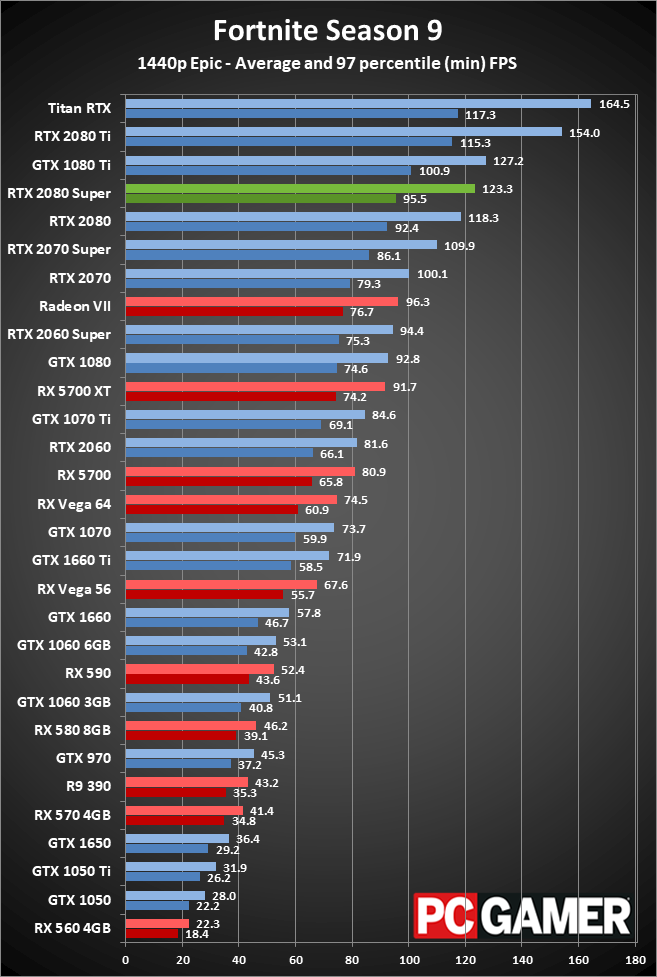

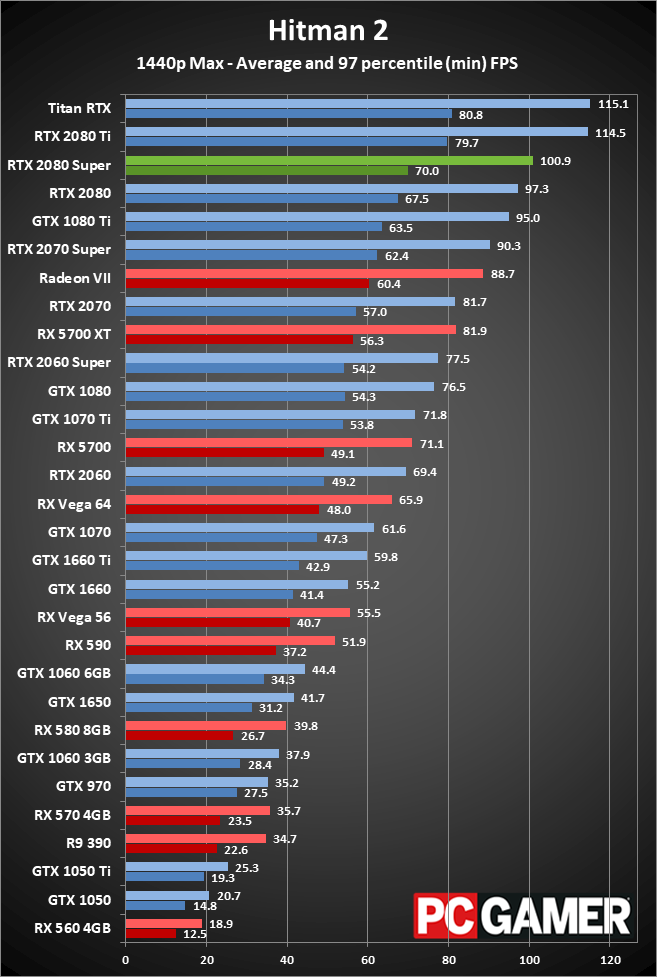
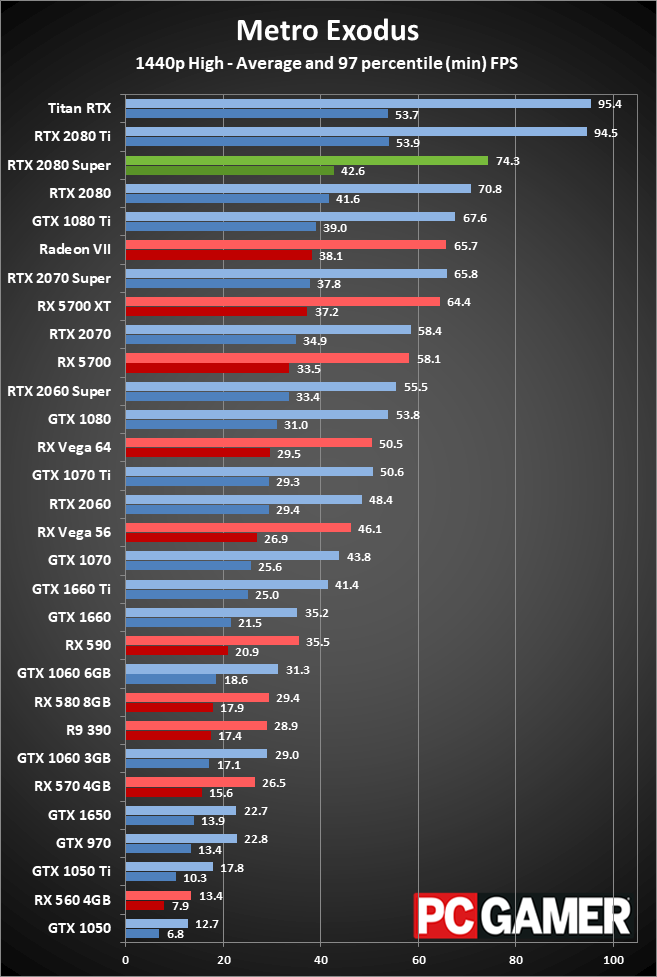
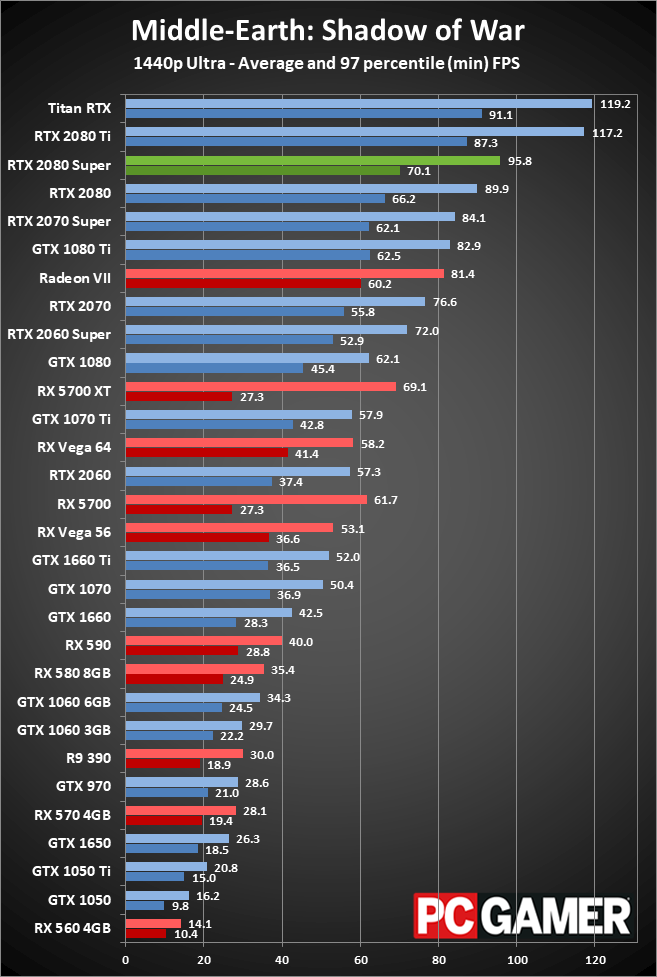
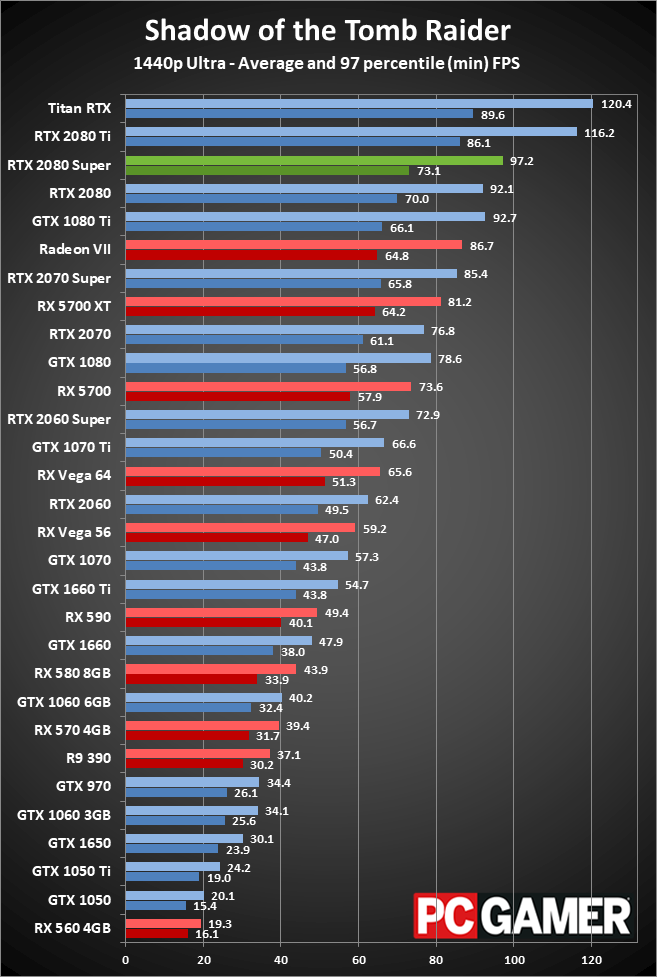
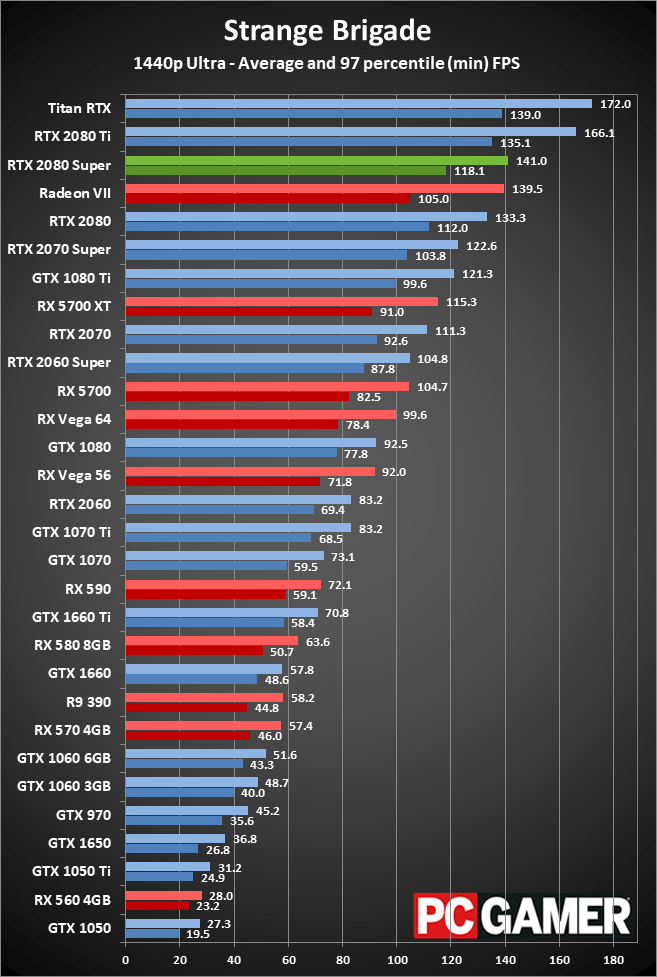
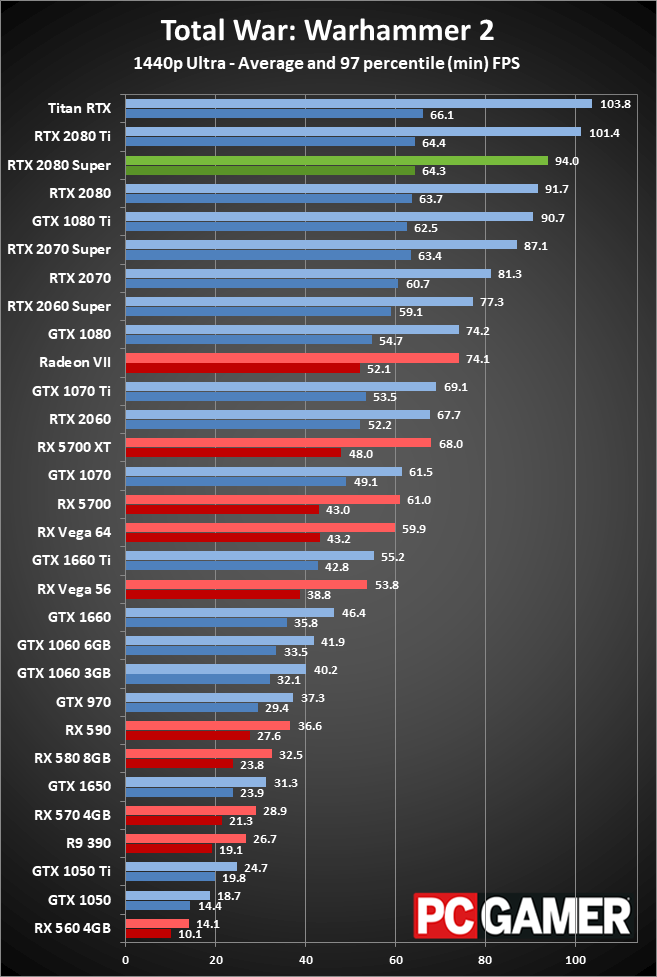
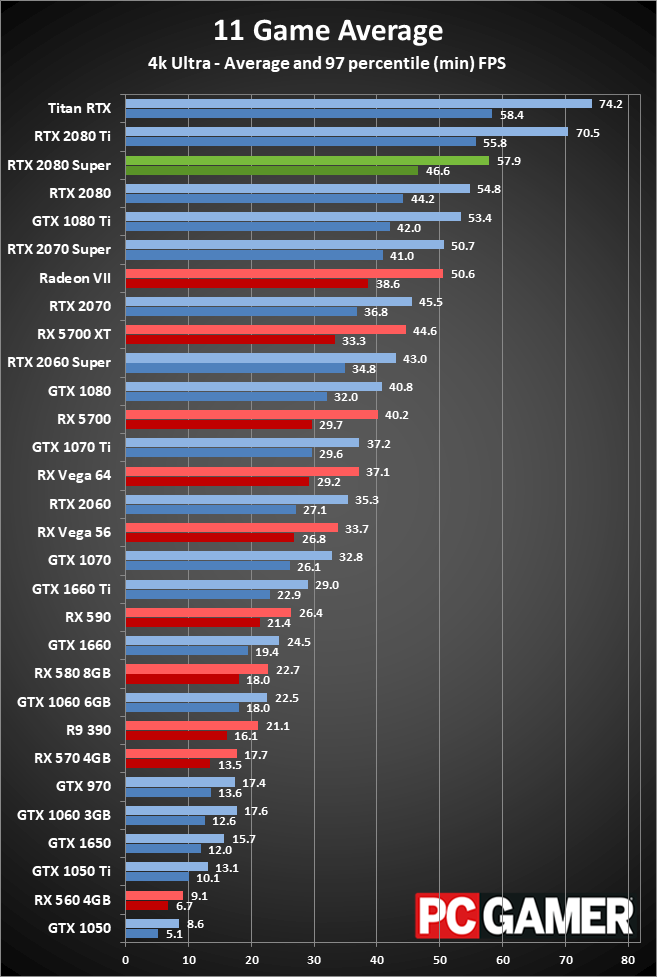
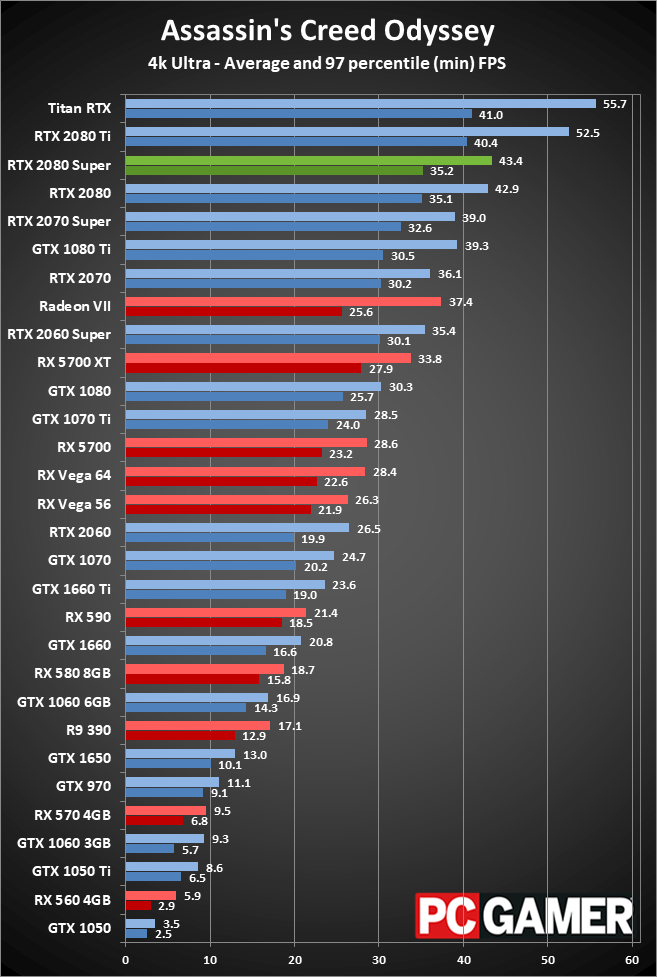

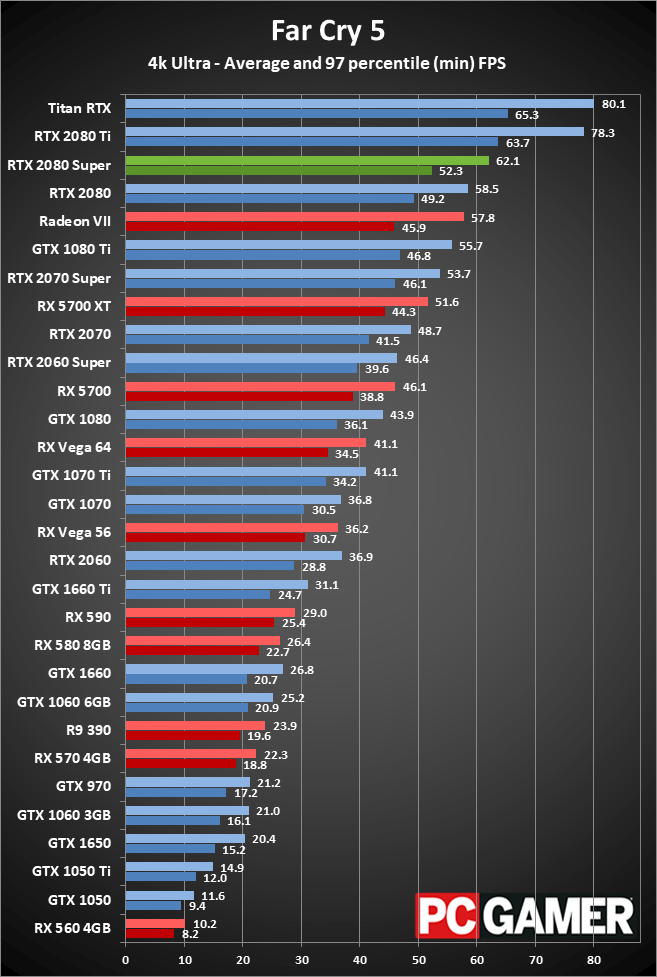
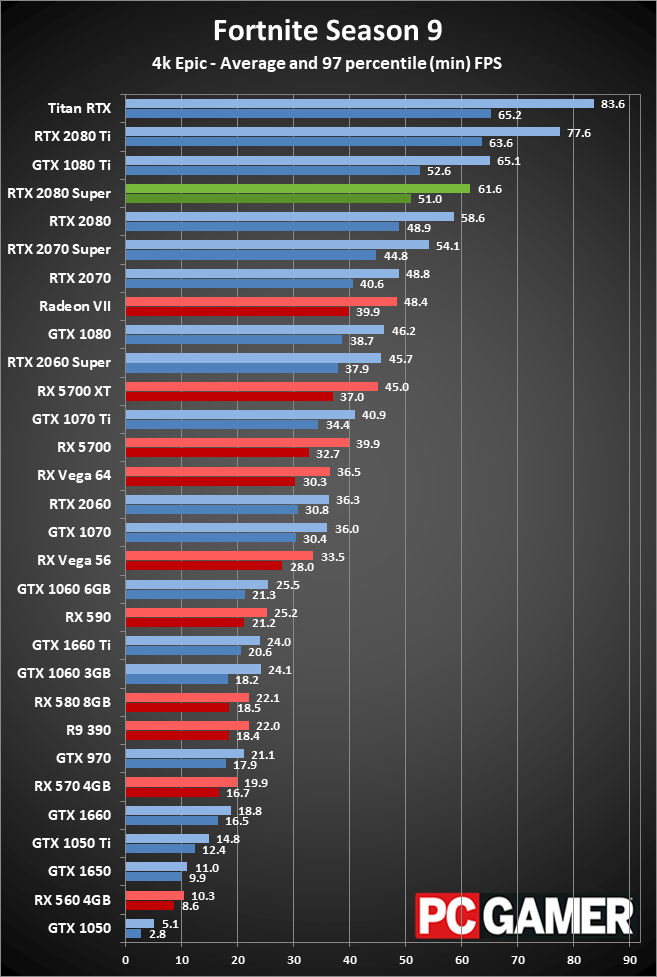


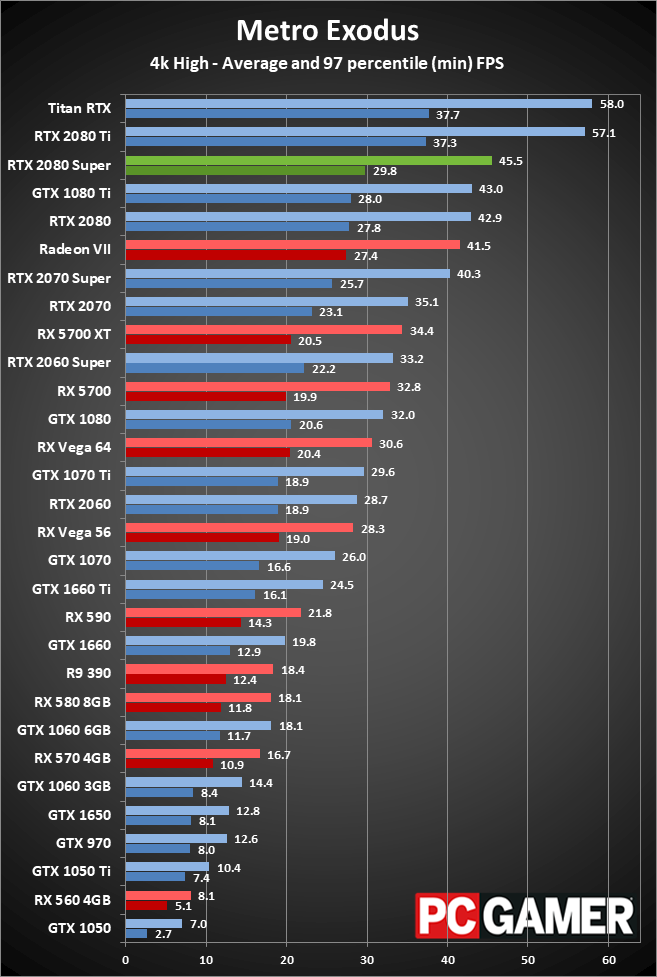

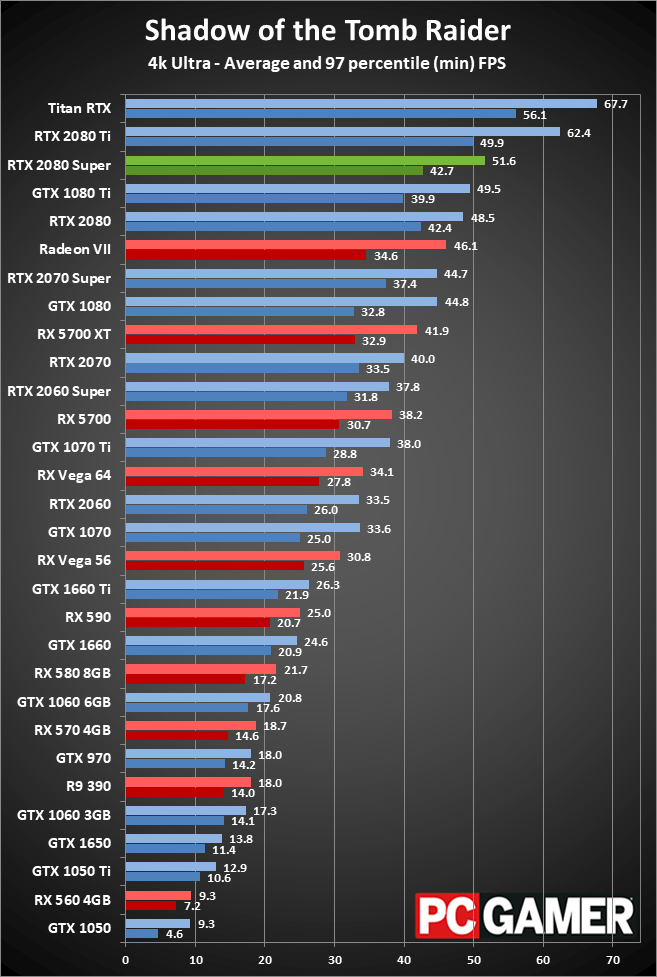

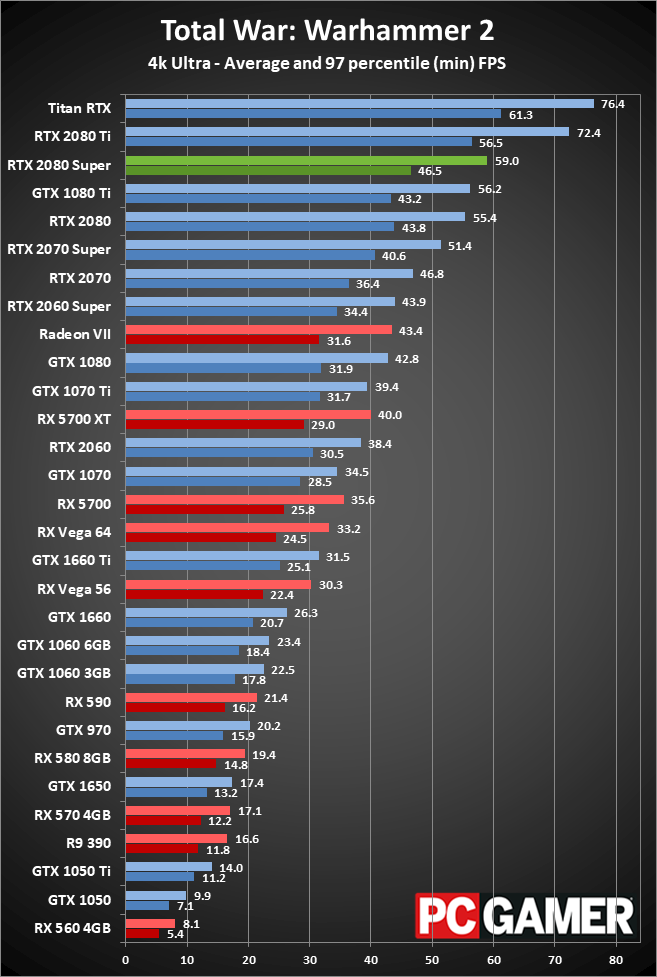
With a bit more time since the last GPU reviews, I've been able to retest several games with updated drivers. That cleared up most of the performance oddities (note that I haven't had a chance to retest any GTX models), and in general Nvidia's GPU hierarchy is pretty straightforward, especially once the GPUs are the main limitation. At 1440p, for example, the 2080 Ti is 17 percent faster than the 2080 Super, which is 5 percent faster than the 2080 FE, which in turn is 7 percent faster than the 2070 Super, and that's 10 percent faster than the RTX 2070, which is 5 percent faster than the 2060 Super, which beats the 2060 by 16 percent.
Other resolutions tell a similar story, though 1080p starts becoming CPU limited at times. The 2080 Super is only 2-3 percent faster on average than a 2080 FE at 1080p, while at 4K the added memory bandwidth helps a bit and it's a whopping 6 percent faster. (Yes, that was sarcasm.) Paper specs don't always tell the whole story, but in cases like this you really don't need to know much more than the specs to estimate how the new model compares to existing cards. 11 percent more memory bandwidth is nice, but not really necessary. Meanwhile, there's only 5 percent more compute performance relative to the 2080 FE, which is why the gains in performance are all less than 11 percent and often less than 5 percent.
The RTX 2080 Super still does great as a card for gaming at 1440p ultra, averaging more than 60fps in every game we tested, though admittedly Assassin's Creed Odyssey just barely squeaks by. 1080p ultra and 144Hz (or higher) is also mostly viable, though you'd want a G-Sync display to smooth out the occasional dips. The only problem is that the exact same thing can be said of the RTX 2080, particularly 2080 cards with a factory overclock. If all 2080 cards were still priced at $700 and up, the 2080 Super would be an easy recommendation. Instead, we have RTX 2080 cards starting at $610, and factory overclocked models for $650. In terms of frames per dollar spent, it's pretty much a wash.
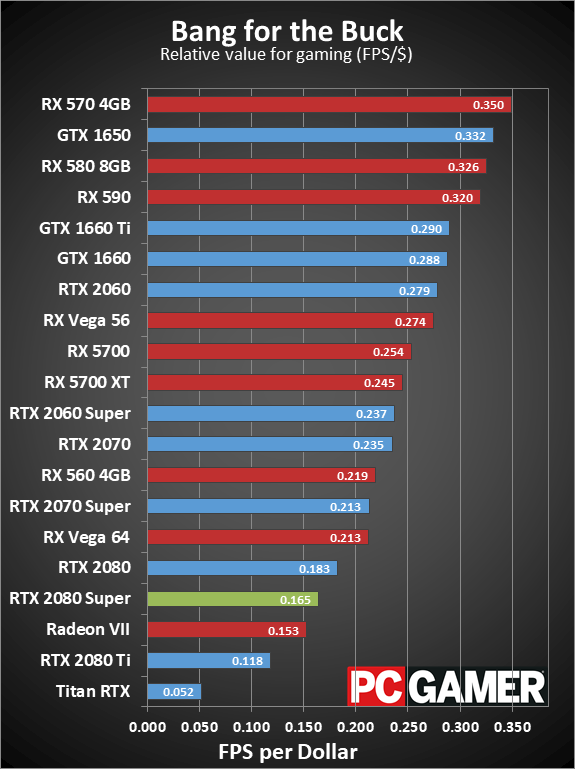
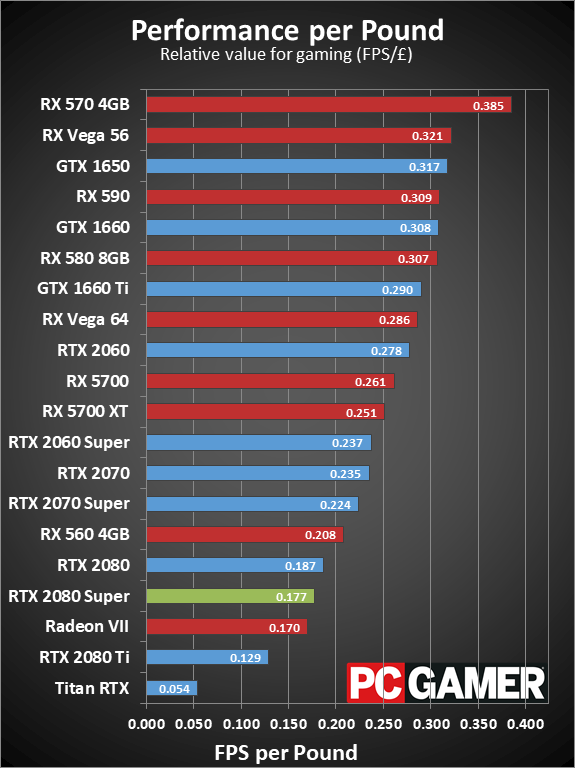
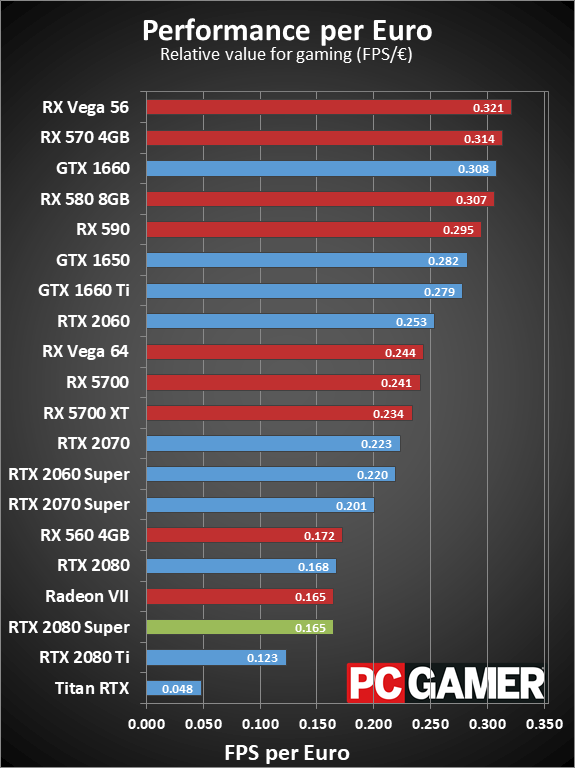

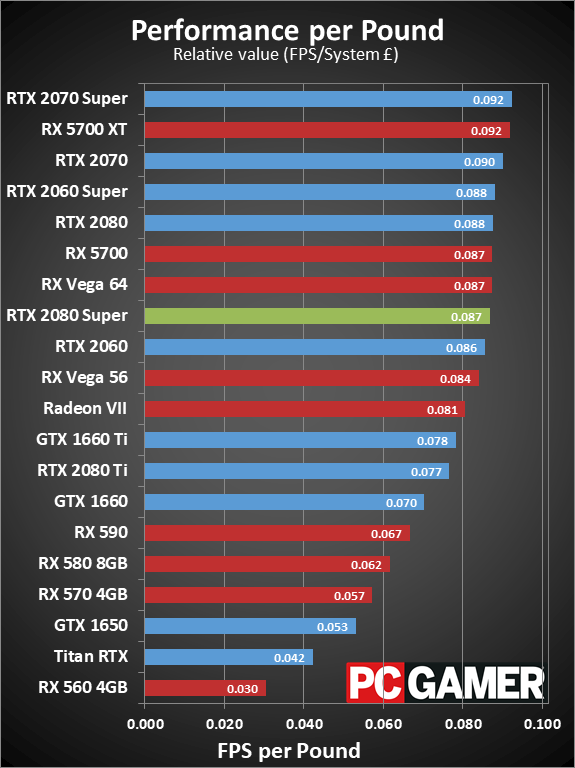

The 2080 Super ends up near the bottom of the GPU 'value' charts, and it's in the upper-middle area on the system charts. Buying the ultimate graphics card for gaming purposes—or in this case the penultimate, not counting the Titan RTX—is rarely about the value proposition. The RTX 2070 Super and RX 5700 XT are at the top of the system charts, balancing price with framerate. The move from the 2070 Super to the 2080 Super meanwhile is a classic case of diminishing returns.
You get 10-15 percent more performance on average, but you'll pay 40 percent more to get there. Even if you're looking at total system cost, it's still 16 percent more money for the same 10-15 percent performance (at most). It's still a perfectly reasonable choice for an extreme gaming PC, if you're into oxymorons like "reasonably extreme," but even high-end gamers are generally better off stepping down to the 2070 Super.
Or if you're serious about building an extreme PC, why not just go whole hog and buy a 2080 Ti? Sure, it's $350 more than the 2080 Super, but it's a bigger step up than the 2080 Super is from the 2070 Super. The 2080 Ti is about 20 percent faster at 1440p and 4K.
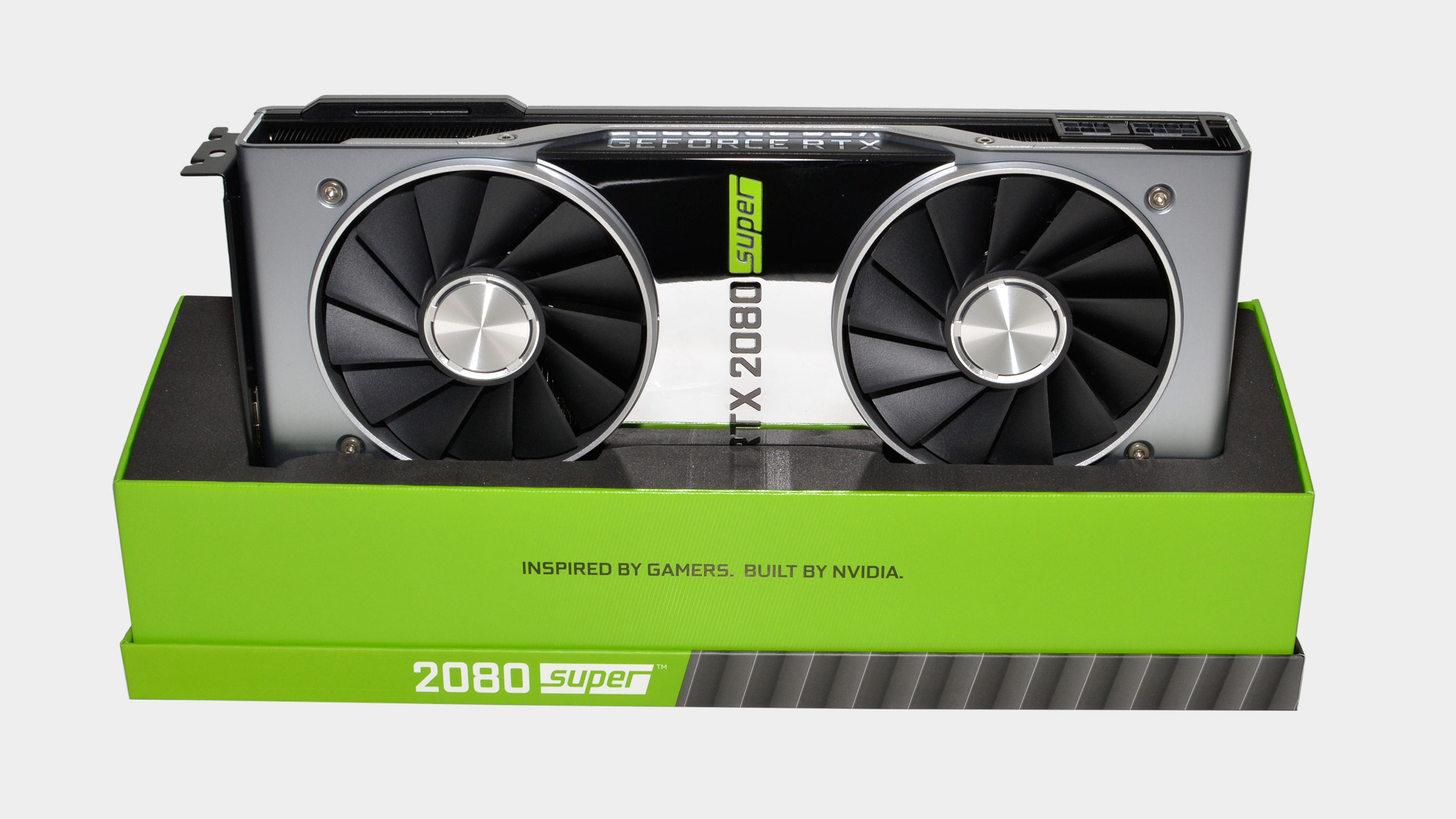
GeForce RTX 2080 Super: technically better than last year's model, by a small margin
As with the other RTX Super cards, the outcome of my RTX 2080 Super testing was entirely predictable. It's a bit faster, thanks to having more cores and higher clockspeeds. It certainly isn't a revolutionary card today, but then it doesn't really need to be. It's meant as a minor upgrade to Nvidia's current products, nothing more nor less. Several months from now, assuming the vanilla RTX 2080 cards actually disappear from shelves and are replaced with 2080 Super models, the 2080 Super will become the only viable $700 (give or take) Nvidia GPU.
The only cards that are substantially faster than the RTX 2080 Super are currently priced so high that only the deepest pockets can reach. The RTX 2080 Ti is about 20 percent faster overall at 4K, but it costs about 50 percent more. Meanwhile, the Titan RTX is 25 percent faster overall at 4K and costs more than three RTX 2080 Super cards. (No one should buy a Titan RTX, unless they're doing something beyond just playing games and need 24GB of VRAM).
I'm still waiting to see a killer app for Nvidia's ray tracing hardware. So far the tech can look slightly better than traditional rasterization techniques, but the performance hit is far too steep in most games. Maybe Wolfenstein Youngblood, the first Vulkan-based game with ray tracing effects, will change things, but I doubt it. Developers need to figure out a way to significantly boost ray tracing performance so that the final results actually look significantly better while still delivering acceptable performance. However, I worry that it won't be until the next generation of Nvidia GPUs (RTX 3000 or whatever they're called) that we have the hardware necessary to truly tackle real-time ray tracing without compromising performance. Let's hope some clever software developers prove me wrong.
The GeForce RTX 2080 Super ends up as the typical update to an existing product. Yes, it's faster than the previous iteration, but not markedly so. If you already have an RTX 2080, you can carry on without losing any sleep. If you're putting together a new PC or upgrading from an existing GPU, and you want something more than an RTX 2070 Super and can't step up to the 2080 Ti, this will have to suffice.
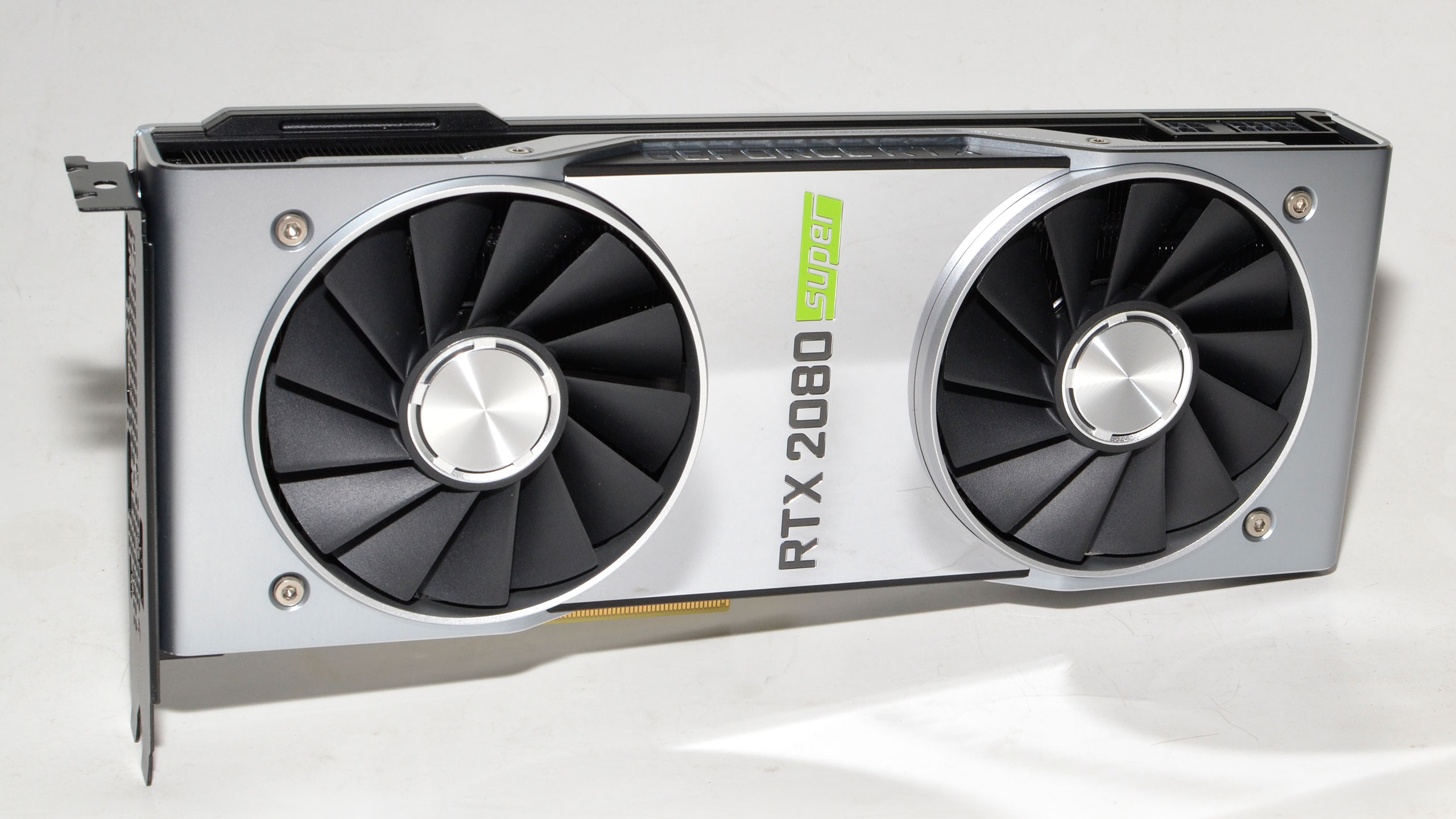




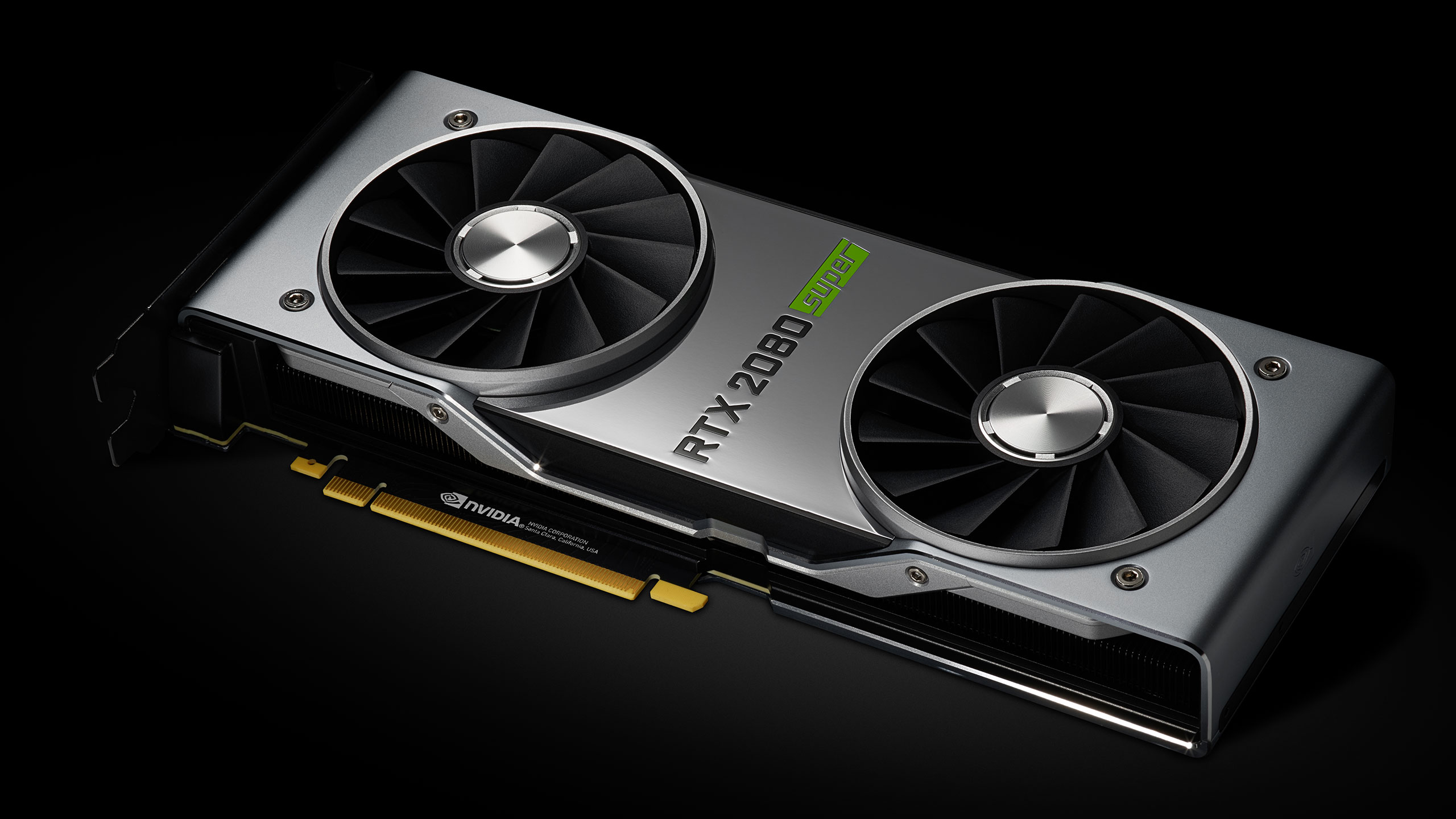
The GeForce RTX 2080 Super has the fastest clocked GDDR6 we've seen so far. It's only slightly faster than the 2080 it replaces, without the Founders Edition shenanigans.
Jarred's love of computers dates back to the dark ages when his dad brought home a DOS 2.3 PC and he left his C-64 behind. He eventually built his first custom PC in 1990 with a 286 12MHz, only to discover it was already woefully outdated when Wing Commander was released a few months later. He holds a BS in Computer Science from Brigham Young University and has been working as a tech journalist since 2004, writing for AnandTech, Maximum PC, and PC Gamer. From the first S3 Virge '3D decelerators' to today's GPUs, Jarred keeps up with all the latest graphics trends and is the one to ask about game performance.


